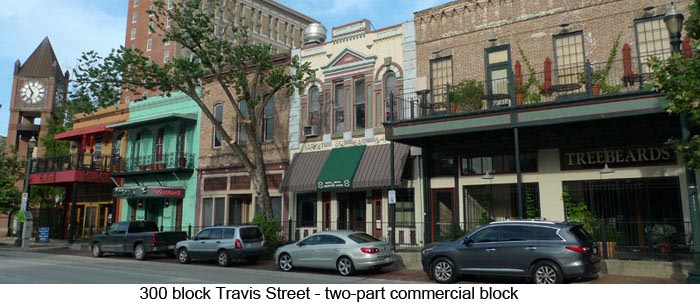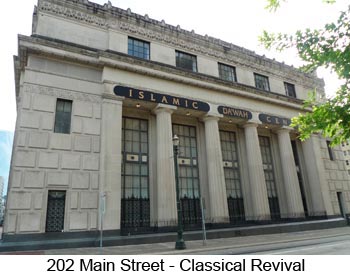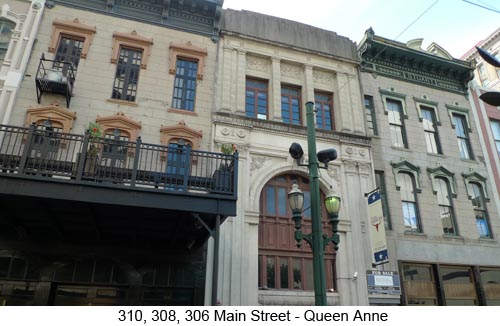
Main Street Market Square
Architectural Styles
The buildings in the Main Street Market Square historic district represent a wide variety of civic and commercial construction over nearly 100 years. The architecture of commercial and civic buildings is described somewhat differently than that of houses. The first way to classify these public buildings is by their form. Some buildings contained only one type of activity (a retail store, restaurant, etc.) These buildings are usually (but not always) one story in height. We call this a “one-part commercial block.” Other buildings have more than one function. They may have stores on the street level, with offices, meeting rooms, or living space on the higher floors. These are called “two-part commercial block” buildings. Most of the buildings in Main Street Market Square are two-part commercial block.

We also can classify these buildings by the architectural details on the front façade (wall). Just like in residential construction, commercial buildings reflected the styles that were popular at the time they were built.
Greek Revival or Classical Revival architecture was often used for banks and government buildings. These buildings had massive columns so that they would look like ancient Greek or Roman temples. That was supposed to give people the sense that the bank or government would be around for a long time. (202 Main Street)
The Queen Anne style was very popular during the late 1800s. These buildings were fancifully decorated. One hallmark of a Queen Anne building is the highly textured wall surface. (310 Main Street)


Italianate architecture was used for many retail buildings. Venice, Italy, was a major shipping port that was known throughout the world. Many Venetian merchants made vast fortunes and built beautiful homes along that city’s famous canals. Italianate architecture was intended to signal that the merchant occupying that building was successful and that the shop sold high quality, stylish goods. Italianate architecture in a commercial setting usually consists of a vertically oriented building with arched, hooded windows and corbelled parapets with elaborate brackets and other ornamentation. (300 Fannin)
Art Deco is the term we now use to describe the “modernistic” architecture of the 1930s. Art Deco architecture is easy to spot. It usually has very clean vertical lines and sometimes ornaments that we would associate with Egyptian or Mayan cultures. (420 Main Street, 500 Fannin Street)
Sometimes the front of a building is changed so that the original details are no longer visible. It was common in the 1950s and 1960s to replace the original, smaller display windows and entry doors with large plate-glass windows in aluminum frames and matching doors. In some cases, those “window walls” have become historic themselves.